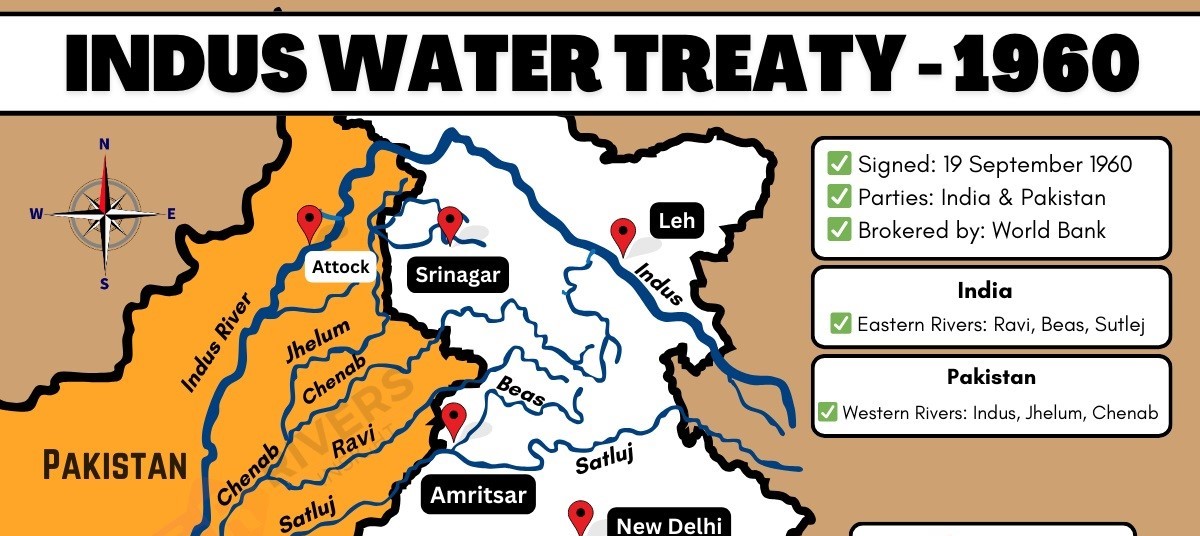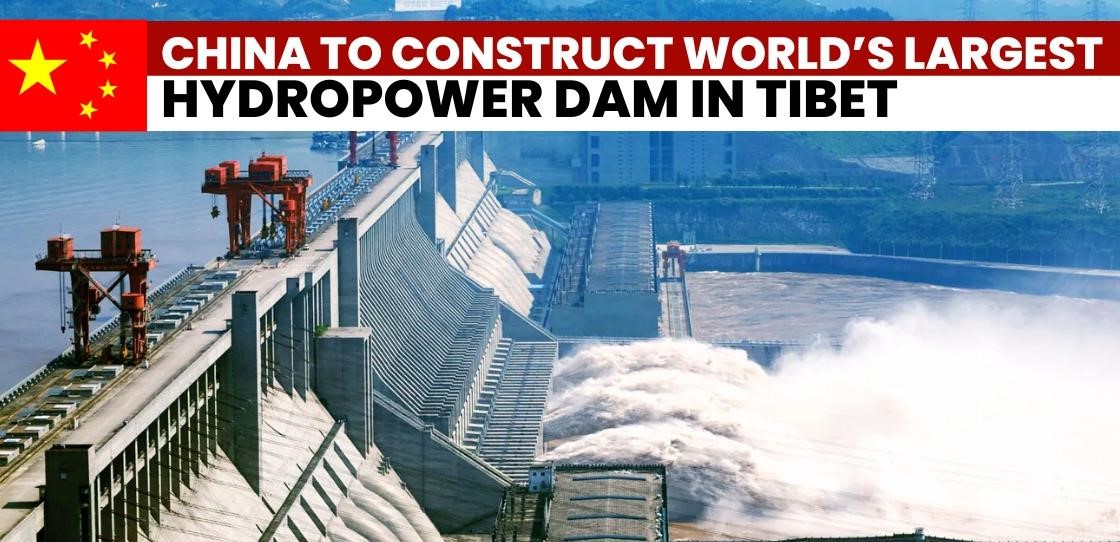My article was published on the “Life of Soldier” website
on 29 Apr 25.
“Blood and water cannot flow together”
– Indian Prime Minister Narendra Modi
The Indus Waters Treaty is a water-sharing agreement between India and Pakistan, signed on September 19, 1960, in Karachi by Indian Prime Minister Jawaharlal Nehru and Pakistani President Ayub Khan. The World Bank brokered it and governs the use of the Indus River system, which includes six rivers: Indus, Jhelum, Chenab, Ravi, Beas, and Sutlej. The Indus River system is critical for both countries’ irrigation, hydropower, and drinking water.
India held the Indus Waters Treaty in abeyance on April 23, 2025, following the Pahalgam terrorist attack that killed 26 civilians. India’s decision, citing national security concerns, grants it greater control over the western rivers, potentially impacting Pakistan’s agriculture and water supply. Pakistan condemned the move as an “act of war,” suspending the Simla Agreement and closing the Wagah border. The World Bank, a treaty signatory, has urged dialogue but lacks enforcement power. This development heightens regional instability and raises concerns about future conflicts and diplomatic relations.
Key Provisions
Division of Rivers. Western Rivers (Indus, Jhelum, Chenab) are allocated to Pakistan for unrestricted use, except for limited Indian uses (e.g., domestic, non-consumptive, and specified agricultural purposes). Eastern Rivers (Ravi, Beas, Sutlej) are allocated to India for unrestricted use.
Water Sharing. Pakistan receives about 80% of the Indus system’s water (around 135 million acre-feet annually), while India gets 20%.
Infrastructure. India can build run-of-the-river dams on Western Rivers for hydropower, but cannot store water beyond specified limits. Pakistan can object to designs that violate the treaty.
Permanent Indus Commission. A bilateral body with representatives from both countries meets regularly to monitor implementation, share data, and resolve disputes.
Context and Significance.
The treaty was necessitated by the 1947 partition, which split the Indus basin, leaving canal headworks in India and irrigated lands in Pakistan. A 1948 standoff, when India briefly cut off water to Pakistan, underscored the need for a formal agreement. It is considered one of the most successful water-sharing treaties globally, surviving three wars.
The Indus system originates in the Himalayas, with major tributaries flowing through Indian-administered Jammu, Kashmir, and Pakistani-occupied Gilgit-Baltistan, making it geopolitically sensitive. In 2016, after a terrorist attack in Uri, India reviewed the treaty. In 2022 and 2023, India issued notices to Pakistan for treaty modification, citing “fundamental changes” like cross-border terrorism and environmental challenges, but no formal revocation has occurred. In 2023, Pakistan sought arbitration over Kishanganga and Ratle, while India challenged the arbitration process, preferring Neutral Expert resolution.
Pakistan, heavily dependent on the Indus for 90% of its water needs, fears reduced flows due to Indian projects or climate change. Delays in its storage infrastructure (e.g., Diamer-Bhasha Dam) exacerbate vulnerabilities. Glacial melt, erratic monsoons, and floods (e.g., 2010, 2022) strain the treaty’s framework, which lacks provisions for climate adaptation.
Recent Development
India has officially held the IWT with Pakistan in abeyance, marking a significant shift in bilateral relations. This decision was announced on April 23, 2025, following a terrorist attack in Pahalgam, Jammu and Kashmir. India invoked Article XII(3) of the IWT and sent a formal notice to Pakistan. The Ministry of Jal Shakti cited Pakistan’s alleged support for cross-border terrorism, shifting demographics, and energy demands as reasons the agreement could no longer continue “in good faith.”
With the treaty placed in abeyance, India is no longer obligated to share information regarding water storage levels or flow in the rivers of the Indus River System with Pakistan. India has ceased sharing hydrological data (e.g., water flow, snowmelt, flood updates) with Pakistan, halted technical meetings, and stopped allowing Pakistani inspections of Indian projects. India is no longer bound by treaty restrictions on building storage or hydropower projects on the western rivers (Indus, Jhelum, Chenab).
Adverse Impact on Pakistan
India’s suspension of the Indus Waters Treaty (IWT) poses significant adverse impacts on Pakistan, particularly in agriculture, water supply, energy, and economic stability.
Agriculture. Pakistan relies on the Indus River system for 80% of its irrigated agriculture, supporting 16 million hectares of farmland. The western rivers (Indus, Jhelum, Chenab) allocated to Pakistan under the IWT provide 93% of its irrigation water. A 10-20% reduction in water availability could lead to significant declines in agricultural output, threatening food security and rural livelihoods. Pakistan’s agriculture sector, which employs 40% of the workforce and contributes 24% to GDP, faces severe risks. While India’s current infrastructure limits immediate large-scale water diversion, future dams or storage projects could reduce water availability, especially during critical sowing seasons (e.g., Rabi and Kharif), reduced flows could lower crop yields for wheat, rice, and cotton—key staples and export crops.
Water Scarcity in Urban Centres. Major cities like Karachi, Lahore, Multan, and Faisalabad depend on the Indus and its tributaries for drinking water and industrial use. Any reduction in river flows, even temporary, could exacerbate existing water scarcity. Pakistan already faces a per capita water availability of ~1,000 cubic meters, close to the “water scarce” threshold. Water rationing, public health crises, and industrial slowdowns could occur, particularly in Punjab and Sindh provinces, which rely heavily on the Indus.
Energy Sector. Pakistan generates significant electricity from hydropower plants like Tarbela (3,478 MW) and Mangla (1,000 MW), which rely on consistent river flows from the Indus and Jhelum. Reduced or irregular water flows could lower power generation, worsening Pakistan’s energy crisis. For example, a 10% reduction in Tarbela’s water inflow could cut its output by hundreds of megawatts, affecting millions of households.
Economic. Energy shortages could disrupt industrial production and increase reliance on costly imported fuels, straining Pakistan’s foreign exchange reserves. A decline in crop production would reduce export revenues (e.g., rice and cotton) and increase food import costs, exacerbating Pakistan’s trade deficit. Reduced agricultural output could lead to job losses in rural areas, driving migration to urban centers and rising social unrest. Higher food and energy prices and potential infrastructure damage from flooding (if India releases water abruptly) could fuel inflation. Pakistan’s external debt (~$130 billion in 2025) limits its ability to fund mitigation measures. A 2023 World Bank study estimated that a 20% reduction in Indus water flows could shave 5-7% off Pakistan’s GDP over a decade.
Social and Political Fallout. Water shortages could spark protests, particularly in Sindh and Punjab, where water allocation disputes between provinces are already contentious. Provinces like Sindh, which rely on downstream flows, may accuse Punjab of hoarding water, exacerbating internal political divides.
India’s Justification and Legitimacy.
India’s justification and Legitimacy for holding in abeyance the Indus Waters Treaty (IWT) hinges on the principle of a “fundamental change of circumstances,” as outlined in Article 62 of the Vienna Convention on the Law of Treaties. New Delhi argues that Pakistan’s continued support for cross-border terrorism, especially following incidents like the April 2025 Pahalgam attack, violates the underlying premise of peaceful bilateral relations that formed the basis of the IWT in 1960. India contends that a country facilitating terrorist activity cannot expect continued cooperation on vital issues like water sharing. While the IWT lacks a unilateral withdrawal clause, India maintains that suspension, not withdrawal, can be a legitimate, proportionate response to persistent security threats.
Diplomatic and Legal Aspects
Pakistan’s Prime Minister Shehbaz Sharif called the suspension an “act of war” and announced retaliatory measures, including suspending the 1972 Simla Agreement and closing the Wagah border.
Pakistan may seek World Bank mediation or international arbitration. The IWT lacks a unilateral exit clause, and India’s suspension may not be easily challenged under international law if framed as a response to terrorism (per Article 62, Vienna Convention). Experts argue India’s suspension is permissible under Article 62 of the Vienna Convention on the Law of Treaties, citing a “fundamental change of circumstances” due to Pakistan’s alleged terrorism support for terrorism. The World Bank, a treaty signatory, has urged dialogue but cannot enforce compliance.
Pakistan may seek neutral expert mediation or arbitration, but India’s refusal to cooperate could render these mechanisms ineffective. Escalating the issue to the UN or other forums may gain Pakistan sympathy but will unlikely force India to reverse the suspension.
The Only Way out for Pakistan.
The only viable way for Pakistan to restore the Indus Waters Treaty is through diplomatic engagement coupled with tangible actions to address India’s core security concerns, particularly those related to cross-border terrorism. India’s decision, justified under the “fundamental change of circumstances” clause in international law, is rooted in accusations of Pakistan’s support for militant activities. Therefore, Pakistan would need to:-
- Stop escalatory rhetoric (including regular and brash nuclear sabre rattling) and retaliatory actions, as these would only harden India’s stance.
- Demonstrate a verifiable crackdown on terror infrastructure operating from its territory, especially groups targeting India.
- Offer security guarantees and confidence-building measures that acknowledge India’s national security concerns to rebuild trust and initiate fresh dialogue.
Ultimately, Pakistan’s path to treaty restoration lies not just in legal appeals but in restructuring the political and security context in which the treaty was suspended. Only by addressing the root causes—especially terrorism—can the IWT be revived in a stable, sustainable way.
Please Add Value to the write-up with your views on the subject.
Link to the article on the website:-
For regular updates, please register your email here:-
References and credits
To all the online sites and channels.
Pics Courtesy: Internet
Disclaimer:
Information and data included in the blog are for educational & non-commercial purposes only and have been carefully adapted, excerpted, or edited from reliable and accurate sources. All copyrighted material belongs to respective owners and is provided only for wider dissemination.
References:-
- Financial Times. “Undermining the Indus Waters Treaty imperils Indian security.” April 26, 2025.
- Reuters. “India suspends Indus Waters Treaty after Pahalgam terror attack.” April 23, 2025.
- Al Jazeera. “Pakistan calls Indus Treaty suspension ‘an act of war’.” April 24, 2025.
- The Hindu. “India halts hydrological data sharing with Pakistan under Indus Treaty.” April 25, 2025.
- BBC. “Water Wars? India wields Indus Treaty amid rising tensions with Pakistan.” April 27, 2025.
- Dawn. “Pakistan to seek World Bank mediation on Indus Treaty row with India.” April 28, 2025.
- Institute for Defence Studies and Analyses (IDSA). Indus Treaty as a Strategic Lever: Implications for India’s National Security. Issue Brief, 2023.
- Rajagopalan, Rajeswari Pillai. India’s Water Diplomacy: Reclaiming the Strategic Narrative. Observer Research Foundation, 2023.
- Observer Research Foundation (ORF). India’s Options under the Indus Waters Treaty: A Strategic Overview. 2022.
- United States Institute of Peace (USIP). Resolving India-Pakistan Water Disputes: A Legal and Strategic Perspective. 2020.
- International Crisis Group. Water Pressure: Climate Risk and Security in Pakistan. ICG Asia Report No. 297, 2018.
- World Bank. Indus Waters Treaty and Current Status of Disputes. [World Bank Briefing Note, 2023].
- Wirsing, Robert G. The Indus Waters Treaty: Political Stability and Water Security in South Asia. Asia-Pacific Center for Security Studies, 2013.
- Salman, Salman M.A. The Indus Waters Treaty: A History of a Treaty that has Survived Wars and Disputes. Water International, Vol. 36, No. 4, 2011.


